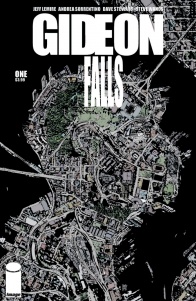On its debut issue, “Gideon Falls” #1 delivers a powerful story wrapped on some truly amazing art. With the makings of a great horror drama, this series could be something truly unique, beautiful, and haunting.
Written by Jeff LemireCover by Andrea Sorrentino
Illustrated by Andrea Sorrentino
Colored by Dave Stewart
Lettered by Steve WandsA brand-new ongoing series from the acclaimed bestselling creative team of Old Man Logan and Green Arrow! The lives of a reclusive young man obsessed with a conspiracy in the city’s trash, and a washed-up Catholic priest arriving in a small town full of dark secrets, become intertwined around the mysterious legend of The Black Barn, an otherworldly building that is alleged to have appeared in both the city and the small town, throughout history, bringing death and madness in its wake. Rural mystery and urban horror collide in this character-driven meditation on obsession, mental illness, and faith.
Some of the best, most disturbing horror stories are those that walk the thin line between a real-world scenario and that of the fantastic supernatural. Those tales usually leave the audience with a sense of uncertainty of whether strange events are truly happening or if they are originated on the fractured psyches of leading characters. “Gideon Falls” seems to be borrowing a lot from this style of storytelling, with page after page of character development, weird occurrences and quite a few scares.
Before going into the story itself, pause and credit needs to be given to Sorrentino on how he generates the right atmosphere with some of his best work so far. Fans of his experimental page and panel designs from series like “Old Man Logan” will be happy to see the artist taking that one step further, with imaginative narrative devices adding to how the story is being told, rather than distracting from it. In one particular moment, Sorrentino distorts an entire page to reflect one character’s view of his surroundings from behind a glass jar, while at the same time serving as a visual metaphor to how twisted his obsessions and world views are.
The art is just as effective when offering more traditional layouts and situations: two longer conversations (one for each of the main characters) reveal a lot about their perspectives and desires simply by conveying facial expressions and body language. These characters feel real and readers can tell more about the story by looking at them rather than just taking their words for it. Sorrentino’s open angles are just as beautiful . . . if revealing decrepit barns in the middle of large abandoned plantations count as beautiful! Those shifts of wider landscapes with panels zoomed in on main characters keep the narrative flow dynamic and easy to follow, even considering the vast amount of details the artist is adding to each page.
Jeff Lemire continues to show his versatility as a comic book artist, with his own experience on drawings being reflected here on how effectively his script welcomes purely visual revelations as a key component of the narrative. The best example of that is a bit of a spoiler (and will remain secret on this review), but suffice to say that there is one turn of a page that, well, might cause trepidations. And the fact that it is shown – not told, not narrated – really delivers on the feeling a good horror story should always bring. That moment where the thin membrane between real and supernatural vanishes.
Lemire’s characters are introduced in a very organic way, with no descriptions being provided outside of sharply written dialogue. That absolute lack of narration adds to the immersion of the story, as readers must enter this world alongside these characters, with no incremental information or understanding, relying on Father Wilfred and Norton’s own actions to move the plot forward. While Father Wilfred reads like a stout, traumatised man, Norton, despite all of his obsessions, evokes a more active stance. While Wilfred still reacts to the world around him, Norton seems convinced that he can reshape it. This contrast between them keeps the issue constantly on its feet, as story beats and scenarios change, remained thematically connected by the events happening to both men. Some pages towards the end take that contrast and make them a visual component as well, with Sorrentino once again understanding what the scrip is requiring of him and delivering in spades. It is obvious in moments like these how Lemire and Sorrentino are partners in crime, this being their third contribution together (“Green Arrow” being the first one).
“Gideon Falls” overall story is as interesting as its characters and art. While it may seem familiar to readers on a first synopses, it is the details on motivation, the layers of mystery and that dual narrative split for Wilfred and Norton that make it unique. And once readers follow through on that crescendo and reach a revealing last page… that is when “Gideon Falls” is sure to have the audience on its grasps.
Final Verdict 9.0 – One of those inaugural issues that deliver on every note, introducing complex characters in mysterious situations and settings, all told with a sharp script that understands the importance of visual storytelling, “Gideon Falls” is one of the best introductions to a new world 2018 has yet to offer.




